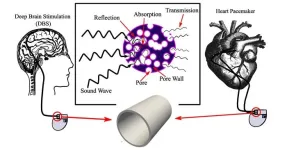(Press-News.org) Different types of cancer have unique molecular ‘fingerprints’ which are detectable in early stages of the disease and can be picked up with near-perfect accuracy by small, portable scanners in just a few hours, according to a study published today in the journal Molecular Cell.
The discovery by researchers at the Centre for Genomic Regulation (CRG) in Barcelona sets the foundation for creating new, non-invasive diagnostic tests that detect different types of cancer faster and earlier than currently possible.
The study centres around the ribosome, the protein factories of a cell. For decades, ribosomes were thought to have the same blueprint across the human body. However, researchers discovered a hidden layer of complexity – tiny chemical modifications which vary between different tissues, developmental stages, and disease.
"Our ribosomes are not all the same. They are specialised in different tissues and carry unique signatures that reflect what's happening inside our bodies," says ICREA Research Professor Eva Novoa, lead author of the study and researcher at the CRG. "These subtle differences can tell us a lot about health and disease."
Ribosomes are made of proteins and a special type of RNA molecule called ribosomal RNA (rRNA). rRNA molecules are the target of chemical modifications, affecting the ribosome’s function. “95% of human RNA is ribosomal RNA. They are very prevalent in our cells,” adds Dr. Novoa.
The researchers looked for all types of chemical modifications across human and mouse rRNA from many different tissues including the brain, heart, liver, and testis. They discovered that each tissue has a unique pattern of rRNA modifications – which they call an ‘epitranscriptomic fingerprint’.
“The fingerprint on a ribosome tells us where a cell comes from,” says Dr. Ivan Milenkovic, first author of the study. "It's like each tissue leaves its address on a tag in case its cells end up in the lost and found."
The team found different sets of fingerprints in diseased tissue samples from patients with cancer, particularly in the lung and testis. “The cancer cells are ‘hypomodified’, meaning they constantly lose some of these chemical marks," says Dr. Milenkovic. "We thought this could be a powerful biomarker," he adds.
The study looked at lung cancer more closely. The researchers obtained normal and diseased tissues from 20 patients with stage I or stage II lung cancer and confirmed that the rRNA from cancer cells is hypomodified. They used the data to train an algorithm which can classify the samples based solely on data from this unique molecular fingerprint.
The test achieved near-perfect accuracy in distinguishing between lung cancer and healthy tissue. “Most lung cancers aren’t diagnosed until late stages of development. Here we could detect it much earlier than usual, which could one day help buy patients valuable time,” says Dr. Milenkovic.
The study was possible thanks to a new technology called nanopore direct RNA sequencing, which permits the direct analysis of rRNA molecules with all its modifications. "It allows us to see the modifications as they are, in their natural context," says Dr. Novoa.
Before the advent of nanopore sequencing, conventional techniques would process RNA molecules in such a way that it would remove the chemical modifications before researchers could study them.
“Scientists typically got rid of ribosomal RNAs because they saw it as redundant information that would get in the way of our experiments. Fast forward a few years, we’ve taken this data out of the junkyard and turned it into a gold mine, especially when information about chemical modifications is captured. It’s an incredible turnaround,” says Dr. Novoa.
The advantage of nanopore sequencing is that it relies on small, portable sequencing devices that can fit in the palm of a hand. Researchers can insert biological samples into the machine, which captures and scans RNA molecules in real time.
The study could distinguish cancer and normal cells by scanning as few as 250 RNA molecules obtained from tissue samples. This is a fraction of what a typical nanopore sequencing device is capable of. "It is feasible to develop a rapid, highly accurate test that looks for cancer’s ribosomal fingerprint using minimal amounts of tissue," says Dr. Novoa.
In the long term, the researchers want to create a diagnostic method which can detect cancer’s fingerprint in circulating RNA in the blood. This would be a less invasive approach because it would only require a blood sample rather than taking tissue samples from patients.
The authors of the study caution that more work is needed before the approach can be used for clinical benefits. “We're just scratching the surface," says Dr. Milenkovic. "We need larger studies to validate these biomarkers across diverse populations and cancer types."
One of the big questions yet to explore is why the modifications change in cancer in the first place. If rRNA modifications are helping cells produce proteins that promote uncontrolled growth and survival, researchers could identify the mechanisms responsible for adding or removing the modifications, potentially leading to new ways of reversing harmful changes.
“We are slowly but surely unravelling this complexity,” says Dr. Novoa. “It’s only a matter of time before we can start understanding the language of the cell,” she concludes.
END
Cancer ‘fingerprint’ can improve early detection
Changes are detectable with near-perfect accuracy by small, portable scanners in just a few hours
2024-12-10
ELSE PRESS RELEASES FROM THIS DATE:
Rethinking the brain pacemaker: How better materials can improve signals
2024-12-10
WASHINGTON, Dec. 10, 2024 – Two years ago, a medical professional approached scientists at the University of Tabriz in Iran with an interesting problem: Patients were having headaches after pacemaker implants. Working together to investigate, they began to wonder if the underlying issue is the materials used in the pacemakers.
“Managing external noise that affects patients is crucial,” author Baraa Chasib Mezher said. “For example, a person with a brain pacemaker may experience interference from external electrical fields from phones ...
Allostatic load, educational attainment, and risk of cancer mortality among us men
2024-12-10
About The Study: This study highlights the detrimental association of not attaining a high school degree, combined with high allostatic load as a marker of chronic stress, with cancer mortality. Efforts to promote educational attainment and address the underlying social determinants of health are imperative in reducing cancer disparities in this population.
Corresponding Author: To contact the corresponding author, Justin X. Moore, PhD, MPH, email jx.moore@uky.edu.
To access the embargoed study: Visit our For The Media website at this link ...
Flaw in computer memory leads to global security fixes
2024-12-10
Cyber security experts studying memory modules in computers have uncovered a key security weakness that has led to worldwide security fixes in AMD computer processors.
The weakness occurs because of ‘BadRAM’ - rogue memory modules that deliberately provide false information to the computer’s processor during startup.
Processors are present in every computer and are necessary to perform every calculation. The computer’s memory (DRAM) is essential for storing code and data. When a computer ...
Race, ethnicity, and sleep in us children
2024-12-10
About The Study: In this cross-sectional study of children’s sleep disparities, racially and ethnically minoritized children exhibited disparities in mean levels and variability of sleep compared with their white peers. These findings suggest that policies and practices should target multiple sleep dimensions among diverse racial and ethnic groups to promote equitable pediatric sleep health.
Corresponding Author: To contact the corresponding author, Yijie Wang, PhD, email yjwang@msu.edu.
To access the embargoed study: Visit our For The Media website at this link https://media.jamanetwork.com/
(doi:10.1001/jamanetworkopen.2024.49861)
Editor’s ...
Geriatric surgery verification program can improve outcomes for older cancer patients in community hospitals
2024-12-10
Key takeaways
The American College of Surgeons Geriatric Surgery Verification program significantly decreases hospital stays among older cancer patients, according to researchers who implemented the program at their institution.
After implementing the program, patients undergoing major abdominal oncologic procedures also maintained higher levels of independence and were more likely to be discharged home.
Researchers found the program addresses the unique needs of older cancer patients by focusing on multiple aspects of care.
CHICAGO — ...
Pew funds 8 teams to conduct collaborative biomedical research
2024-12-10
PHILADELPHIA—The Pew Charitable Trusts announced today the eight pairs of researchers who will make up its 2024 class of Innovation Fund investigators.
These 16 acclaimed scientists—all alumni of Pew’s biomedical programs in the United States and Latin America—will collaborate on interdisciplinary research projects that explore foundational questions about human biology and disease. By combining their expertise in topic areas ranging from cell biology and immunology to neuroscience and genetics, these partnerships will help to advance scientific discovery and improve human ...
Finding innovative ways to address kidney cancer leads to DoD grant
2024-12-10
Weill Cornell Medicine has received a $1.4 million, four-year grant from the U.S. Department of Defense to investigate a new therapeutic approach for the most common form of kidney cancer.
The grant is one of 10 Idea Awards the department funded this year to support innovative, high-risk, high-reward science that could lead to a paradigm shift in cancer care. The funding will enable principal investigators Dr. Lorraine Gudas and Dr. David Nanus to explore a cellular reprogramming strategy that may improve how patients ...
Americans are uninformed about and undervaccinated for HPV
2024-12-10
LOS ANGELES — The human papillomavirus (HPV), a common sexually transmitted infection, accounts for 70% of all throat cancers, according to the National Cancer Institute. While commonly associated with cervical cancer, throat cancer is now the most common type of HPV-related cancer.
However, the majority of American adults are unaware that HPV can cause throat cancer and are not taking advantage of the one proven method for prevention — the HPV vaccine.
These are the conclusions of two recent studies from the USC Head and Neck Center, part of Keck Medicine of USC and the USC Caruso Department of Otolaryngology – ...
KTU scientists developed a nanolaser: silver nanocubes enable light generation
2024-12-10
Kaunas University of Technology (KTU), Lithuania researchers and scientists from Japan have developed a unique nanolaser. Although the dimensions of this laser are so small that its structure can only be seen through a powerful microscope, its potential is vast. With applications in early medical diagnostics, data communication, and security technologies, this invention could also become a key tool for the study of light and matter interactions.
Depending on the application, lasers differ in the way light is amplified and produced, which determines the colour of the radiation and the quality of the laser ...
Insilico Medicine nominates orally available pre-clinical candidate targeting NLRP3 to treat inflammation and central nervous system diseases
2024-12-10
As the first line against microbial infections or endogenous cellular damage in our body, the innate immune system utilizes NLRs (NOD-like receptors) to sense the molecules triggering microbial infection and damage, thus ensuring the proper immune response function. In the NLRs family, NLRP3 is the most characterized member, and its overactivation can lead to excessive production of pro-inflammatory cytokines and chemokines, driving pathological processes in various inflammatory diseases.
CAMBRIDGE, Mass., Dec 10, 2024 --- Insilico Medicine (“Insilico”), a clinical-stage generative artificial intelligence (AI)-driven drug discovery ...
LAST 30 PRESS RELEASES:
Tracing the quick synthesis of an industrially important catalyst
New software sheds light on cancer’s hidden genetic networks
UT Health San Antonio awarded $3 million in CPRIT grants to bolster cancer research and prevention efforts in South Texas
Third symposium spotlights global challenge of new contaminants in China’s fight against pollution
From straw to soil harmony: International team reveals how biochar supercharges carbon-smart farming
Myeloma: How AI is redrawing the map of cancer care
Manhattan E. Charurat, Ph.D., MHS invested as the Homer and Martha Gudelsky Distinguished Professor in Medicine at the University of Maryland School of Medicine
Insilico Medicine’s Pharma.AI Q4 Winter Launch Recap: Revolutionizing drug discovery with cutting-edge AI innovations, accelerating the path to pharmaceutical superintelligence
Nanoplastics have diet-dependent impacts on digestive system health
Brain neuron death occurs throughout life and increases with age, a natural human protein drug may halt neuron death in Alzheimer’s disease
SPIE and CLP announce the recipients of the 2025 Advanced Photonics Young Innovator Award
Lessons from the Caldor Fire’s Christmas Valley ‘Miracle’
Ant societies rose by trading individual protection for collective power
Research reveals how ancient viral DNA shapes early embryonic development
A molecular gatekeeper that controls protein synthesis
New ‘cloaking device’ concept to shield sensitive tech from magnetic fields
Researchers show impact of mountain building and climate change on alpine biodiversity
Study models the transition from Neanderthals to modern humans in Europe
University of Phoenix College of Doctoral Studies releases white paper on AI-driven skilling to reduce burnout and restore worker autonomy
AIs fail at the game of visual “telephone”
The levers for a sustainable food system
Potential changes in US homelessness by ending federal support for housing first programs
Vulnerability of large language models to prompt injection when providing medical advice
Researchers develop new system for high-energy-density, long-life, multi-electron transfer bromine-based flow batteries
Ending federal support for housing first programs could increase U.S. homelessness by 5% in one year, new JAMA study finds
New research uncovers molecular ‘safety switch’ shielding cancers from immune attack
Bacteria resisting viral infection can still sink carbon to ocean floor
Younger biological age may increase depression risk in older women during COVID-19
Bharat Innovates 2026 National Basecamp Showcases India’s Most Promising Deep-Tech Ventures
Here’s what determines whether your income level rises or falls
[Press-News.org] Cancer ‘fingerprint’ can improve early detectionChanges are detectable with near-perfect accuracy by small, portable scanners in just a few hours





